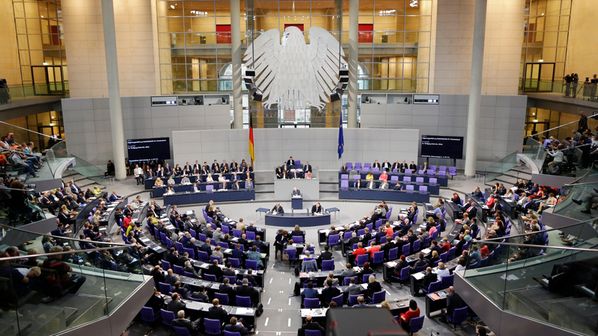
Germany's parliament, the Bundestag, is getting to big. After the September 20, 2021 election, the nominal size of 598 members ballooned to an astounding 735 members. The intricacies of Germany's election system awards overhang mandates (Überhangmandate) to restore proportionality if a party wins too many direct mandates in the 299 electoral districts. Germans have two votes: one for a local candidate in one of 299 electoral districts, and one for a political party. The latter is what counts for the overall composition of the parliament. It comes at no surprise, then, that Germany seeks electoral reform to avoid XXL Bundestag. Can Germany fix its problem? There is no shortage of proposals, but there are concerns about each of them. I have a new proposal that may help fix the problem, based on my research paper) that provides for improved local representation while maintaining (strict) proportionality. So how does the current system work, and how can my proposal fix it?
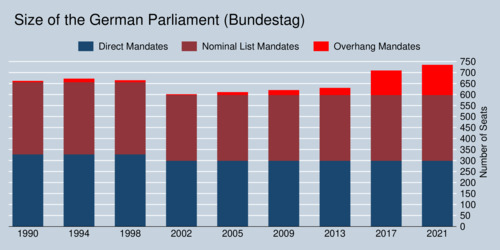
click on image for high-resolution PDF version
Since a first parliamentary size reform in 2002, Germany's parliament is meant to elect 598 members, half of them through simple plurality in 299 electoral districts. My recent blog Germany's new political landscape in maps features a map of which parties won direct mandates. Unsurprisingly, it is dominated by the two larger parties (Social Democrats and Christian Democrats) with a handful of seats going to the Green Party in a number of urban areas and university towns, and a number of seats going to the AfD party where it is particularly strong in the states of Saxony and Thuringia. The shares of direct mandates is quite distinct from the popular vote shares, and this is where it gets difficult. Parties keep their direct seats, and a formula calculates the number of minimum mandates each party is entitled to so that parties can also draw parliamentarians from their provincial party lists. Then the size of the parliament is increased until proportionality of the vote shares is restored. Depending on the magnitude of the initial seat-share vote-share discrepancy, parliament could swell to even larger numbers than 735.
It is rather obvious that the problem is with the direct mandates. Local representation is important, which is why some countries like Canada still use first-past-the-post elections where the candidate with the most votes in each riding wins, even if the vote share is barely 30% in some cases. One reform proposal in Germany (supported by three smaller parties) aims to reduce the number of electoral districts from 299 to 250. This would curb the growth of the Bundestag but would reduce local representation. The Union parties proposed a milder version (reduction to 280 districts) along with a higher degree of non-compensation of overhang mandates. This proposal is seem to favour them, however. A more radical proposal comes from the Social Democrats, which would limit parliament to 690 and force some parties to give up direct mandates. But that would mostly affect the Union parties, and it is unclear which direct mandates would need to be curtailed and would lack local representation.
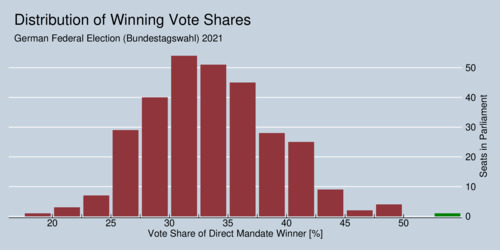
click on image for high-resolution PDF version
Two charts make the case for reform of the direct mandates. The first chart, above, shows the distribution of the vote shares that won each of the 299 direct mandates in the last election. Half of the direct mandates were won with less than one third of the votes. The Dresden-II district was won with just 19% of the vote, in what turned out as a tight five-way race! Only a single district, Aurich-Emden, was won with more than 50% of the vote (by the Social Democratic candidate). This chart makes it clear that local representation is as highly fragmented as representation overall. It is difficult to argue that someone elected with just a third of the vote has a strong mandate to represent the entire district. Direct mandates make more sense when directly-elected candidates have more than half of the voters behind them. That is clearly no longer the case.
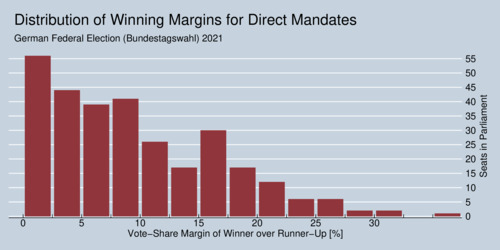
click on image for high-resolution PDF version
The second chart shows the distribution of the winning margins in each electoral district, that is the difference between the vote share of the winner and the vote share of the second-placed runner-up. Half of all districts are won with less than an 8% margin, and a quarter of all districts are won with less than a 3.5% margin. Given how small the winning margins are in each case, the mandate of the winner to represent the district is as narrow as the winning margin: it is a weak claim to representation.
My electoral model offers a way out. It has a simple guiding principle:
Conditional on achieving nationwide proportionality of representation, the best local representation is achieved when the most voters are represented by their preferred party choice in each electoral district and all members of parliament represent a district.
‘Germany's parliament can slim down and even improve local representation.’
Applying the above principle leads to a novel way of reforming Germany's parliament and keep it to 598 members. The starting point is proportionality at the provincial level, with compensation if the sum of provincial allocations falls below the national allocation. In Germany, candidates are drawn from provincial lists. This also enables allocating seat assignments within each province effectively. The table below shows how seats are distributed proportionally to each party within each province (Bundesland). Then the totals are added up and compared to the ideal nationwide distribution that would have emerged had all seats been allocated proportionally at that level. Because seats are determined in each province separately, the two allocations will not match perfectly. This leads to a small discrepancy—a surplus or deficit of a few seats at most. The question is then how to compensate. It would be expedient to compensate a party for any deficit from the national allocation. By that rule, in the last election the CDU would have gained three extra seats as compensation, and the Green Party one seat. Parliament would have grown by four seats from 598 to 602. The table below shows the provincial allocations that would have emerged, along with compensation seats where needed.
| Province (Bundesland) |
Seats for each Party | Total Seats |
||||||
|---|---|---|---|---|---|---|---|---|
| SPD | Union | GRÜNE | FDP | AfD | LINKE | SSW | ||
| Berlin | 6 | 4 | 6 | 3 | 2 | 3 | — | 24 |
| Brandenburg | 7 | 3 | 2 | 2 | 4 | 2 | — | 20 |
| Baden-Württemberg | 18 | 20 | 14 | 13 | 8 | 3 | — | 76 |
| Bayern | 19 | 34 | 15 | 11 | 10 | 3 | — | 92 |
| Bremen | 2 | 1 | 1 | — | — | — | — | 4 |
| Hessen | 13 | 11 | 8 | 6 | 4 | 2 | — | 44 |
| Hamburg | 4 | 2 | 3 | 1 | 1 | 1 | — | 12 |
| Mecklenburg-Vorpommern | 4 | 2 | 1 | 1 | 2 | 2 | — | 12 |
| Niedersachsen | 21 | 15 | 10 | 7 | 5 | 2 | — | 60 |
| Nordrhein-Westfalen | 40 | 35 | 22 | 16 | 10 | 5 | — | 128 |
| Rheinland-Pfalz | 10 | 8 | 4 | 4 | 3 | 1 | — | 30 |
| Schleswig-Holstein | 6 | 5 | 4 | 3 | 2 | 1 | 1 | 22 |
| Saarland | 3 | 2 | — | 1 | 1 | 1 | — | 8 |
| Sachsen | 7 | 6 | 3 | 4 | 9 | 3 | — | 32 |
| Sachsen-Anhalt | 5 | 4 | 1 | 2 | 4 | 2 | — | 18 |
| Thüringen | 4 | 3 | 1 | 2 | 4 | 2 | — | 16 |
| Total all Bundesländer | 169 | 121 | 95 | 76 | 69 | 33 | 1 | 598 |
| Ideal Nationwide Distribution | 168 | 124 | 96 | 75 | 68 | 32 | 1 | 598 |
| Surplus(+)/Deficit(–) | +1 | –3 | –1 | +1 | +1 | +1 | — | — |
| Compensation | — | 3 | 1 | — | — | — | — | 602 |
Having achieved proportionality at the provincial and federal level, the 598 candidates are assigned to individual districts in order to achieve effective local representation. Specifically, elected candidates in each province are assigned to districts within that province. That is where my electoral model offers an elegant solution that actually enhances local representation.
The solution is to assigning all members of parliaments to represent electoral districts in such a manner that it maximizes representation from preferred parties. Mathematically, it is a simple maximization problem that is known as a mixed-integer programming. It is hardly more complicated than today's algorithm to calculate overhang mandates. Because there are 299 districts and 598 members, there are two members assigned to each district. That is an improvement over the existing local representation. For the first time, each member of parliament would have a meaningful connection to a local constituency.
Mathematically, this can be formulated as a maximization problem where \(v_{i,p}\ge0\) is the number of votes for party \(p\) in district \(i\), and \(x_{i,p}\in\{0,1\}\) is a binary variable that indicates whether party \(p\) represents district \(i\). Each party has won \(n_p\) seats according to the election result. Then: \[ \max \sum_i\sum_p x_{i,p}\cdot v_{i,p} \] such that each district has two members of parliament, \(\forall i: \sum_p x_{i,p}=2\), and such that each party's number of seats adds up to the total allocated by proportional representation, \(\forall p: \sum_i x_{i,p}=n_p\). This procedure assures that the assignment solution maximizes the total number of voters who are represented by their preferred party in each province.
There are two issues to consider yet. First is the varying participation rates across districts. The optimization model punishes districts with a low turnout as they may end up occasionally with parties that are not representing either of the two front-runners in a district. This is the collective price to pay for low turnout, and it is an incentive for voters to go and vote. The higher the turnout, the higher the chance of having a member of parliament from the preferred party. This incentive is consistent with the maximum representation principle. The corollary is that the system minimizes misrepresentation, and this means that districts with very low turnout do not sufficiently care about their choice of representation. Competition for turnout that drives up turnout is healthy for democracies.
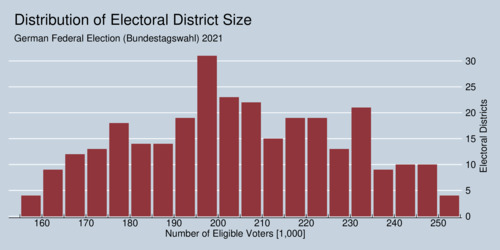
click on image for high-resolution PDF version
The second issue is more problematic. Electoral districts vary in size, as the diagram above shows. The smallest districts (e.g., Altmark, Duisburg II, Essen II, Coburg) have less than 160,000 voters, while others (Mainz, Fürth, and Ostallgäu) have more than 250,000 voters. The coefficient of variation is 11.6%, far from insubstantial. Put another way, the largest district is 63% larger than the smallest district. This means that voters in small districts would get penalized for living in small districts, as they would more often get represented by smaller parties. This problem can be fixed through an adjustment factor \(w_i\) for each district. Let \(V_i\) be the total number of eligible voters in each district. Then \(\bar{V}\equiv \sum_i V_i/n\) is the average number of eligible voters across all districts. Define the adjustment factor \(w_i\equiv \bar{V}/V_i\) to give greater weight to small districts. Then the adjusted optimization problem becomes \[ \max \sum_i w_i\cdot \sum_p x_{i,p}\cdot v_{i,p} \] Rescaling the optimization problem will lead to a smaller number of people represented by their preferred party overall, but will correct the distortion that would otherwise disadvantage small districts. In order to improve the outcome, district boundaries should be redrawn to reduce the disparity across district sizes.
To summarize, here are the key ingredients of the new system:
- Germany's parliament would have 598 members and 298 electoral districts. Overhang mandates are only needed to compensate for small discrepancies between nationwide allocation and the sums of provincial seats.
- Voters vote for political parties and the seats in the Bundestag are allocated proportionally by national share of the vote, subject to the 5% threshold (with an exemption for national minority parties).
- Each member of parliament has to represent an electoral district.
- Each electoral district is represented by two members of parliament.
- Which party represents which district is determined, within each province (Bundesland), in such a manner that the total number of voters represented by their preferred choice is maximized.
- The two members of parliament representing a district serve as "senior" and "junior" representatives of that district in order of the number of votes that the respective parties received in this district. Parliamentary protocol may recognize this distinction appropriately.
Unlike the current system, where more than half of the members of parliament have no direct connection to an electoral district, now all members of parliament have a mandated connection and will be asked to address the needs of their particular constituencies. The two members representing each constituency will have a duty to maintain a visible presence in their district: a constituency office that members of the public can visit to talk to their Member of Parliament or their staff.
What would happen to Germany's famed two-vote election ballot? It does not need to be jettisoned. The Erststimme (first vote) would no longer determine a winner on a first-past-the-post basis, but it can still help determine the assignment of parties to districts.
The attached table shows the calculations of who would optimally represent each electoral district, assigning each party's overall seats in each province (Bundesland) to the electoral districts in that province. The senior member of parliament is the one with more votes than the junior member of parliament from each district. Only when a party has more than 50% of seats from a province will one party represent one or more districts with two members. Otherwise (as is the case in 2021), each district is represented by members from two different parties. The allocation mechanism uses the adjustment to equalize the size disparity of electoral districts.
TABLE (PDF FILE)
with optimal seat allocations for each electoral district in Germany
based on the September 2021 election.
The last three columns in the table show the optimal seat assignments for senior seat and junior seat. A green background indicates that the senior seat is occupied by the same party as the conventional first-past-the-post winner. A red background indicates that the senior seat goes to a party other than the first-ranked party. Also shown is the share of voters represented in each district by the two parties representing it. A green background indicates a majority, a yellow background indicates that a least one third of voters are represented, and a red background indicates that less than one third of voters are represented.
The table above includes an allocation of seats to the party Die Linke, because they cleared a secondary hurdle even though they missed the 5% primary hurdle. In my electoral system above there is no obvoius mechanism to replace the secondary rule, which allows a party to take part in the seat allocation if they gain three direct mandates.
If Germany wants to limit the size of its parliament, keep its two-vote election ballot, and improve local representation, the electoral model presented here offers an elegant alternative to the current system.
![[Sauder School of Business]](logo-ubc-sauder-2016.png)
![[The University of British Columbia]](logo-ubc-2016.png)